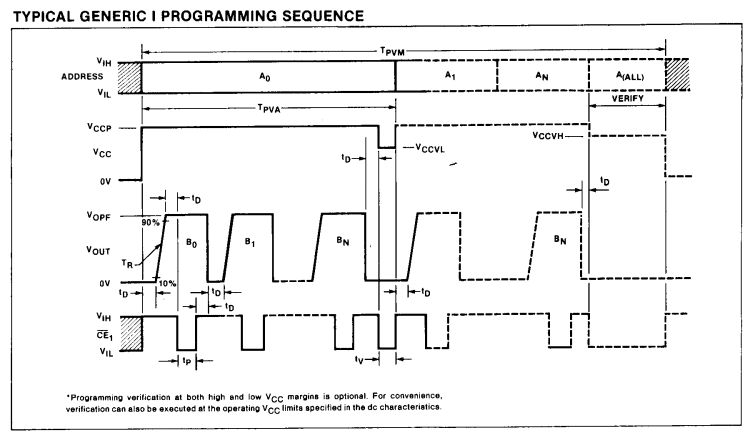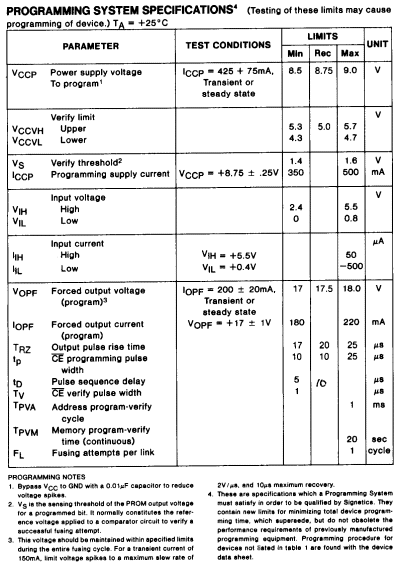
The Signetics family of Schottky PROMs are high performance bipolar devices which use a nickel/chromium (nichrome) alloy fuse to provide the many benefits of field programming. All Signetics Schottky PROMs use a common fuse design and programming circuitry. This means that a programmer capable of programming any Signetics PROM should program the entire family. Because of the pinout variation a small selection of socket adapters may be required. Programming is accomplished by application of voltages above those used for normal operation, therefore, no special pins are required for programming (except the 82S115 which has two pins: FE1 and FE2). The programming voltages and timing requirements make unintentional programming virtually impossible. Arrays of devices may be programmed in the users circuit, it desirable, and isolation of programming voltages is provided.

Signetics encourages the purchase of programming equipment from a manufacturer who has a full line of programming products to otter. Signetics also encourages the manutacuturers of PROM programming equipment to submit their equipment for veritication of electrical parameters and programming procedures. Information on manufacturers equipment is available on request from Bipolar Memory Marketing.
In order to consistently achieve excellent programming yields, periodic calibration of the programming equipment is required. Consult the equipment manufacturer for the recommended calibration interval. Records of programming yield, by device type, should be kept and any downward trend or sudden change should be considered as an indication of a need to recalibrate programming equipment.
The following information is provided for reference and completeness of individual data sheets.
SIGNETICS DISCOURAGES THE CONSTRUCTION AND USE OF "HOMEMADE" PROGRAMMING EQUIPMENT.
The generic family of Schottky PROMs uses no special pins for programming. The programming mode is evoked by raising the Vcc pin to +8.76 +/- .25V. This voltage is referred to as Vccp. The address pins remain TTL compatible and are used to address the unique word to be programmed. The outputs are used to supply fusing current in the programming mode.
Programming is performed one bit at a time, the word address is set up on the address inputs and the fuse to be programmed is selected by raising the output (corresponding to the bit in the word) to + 17V +/- 1 V. This voltage is known as Vopf and must be supplied by a voltage source with a low impedance and very test transient response. Reliable programming depends on the Vopf power supply and circuitry. Iopf is the current which should be drawn by the part during the programming sequence VOPF should be maintained and Vopf monitored. If the current is not within specification reliable fusing can not be assured.
Unprogrammed parts are supplied with all bits "zero", only the bits Intended to be "one" will be programmed.
A fuse which does not blow during the first programming cycle should be considered a defective device and should be discarded. Verification of the device may be performed after all addresses have bean programmed.

The programming procedure for fusing the oxide-isolated vertical fuse PROMs is under development, and is not available at the time of printing. Please contact the factory for details on the Generic 11 programming method.